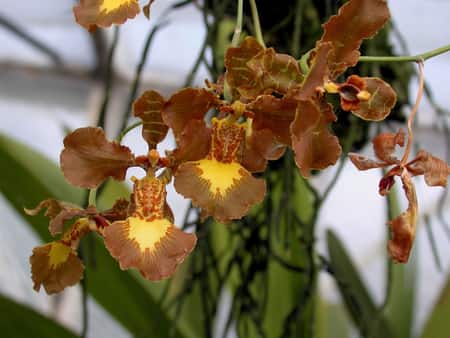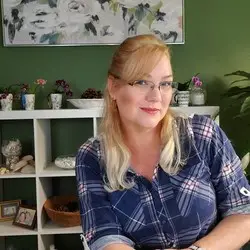Every once in a while, you’ll encounter some spots on an orchid leaf that look either like transparent blisters or brown scale spots that don’t come off when rubbed. These could be edema so don’t reach for the pruning shears quite yet. Edema is not contagious and is not potentially a harm to your orchid.Why does edema take place in the first place?
Edema on orchid leaves appears for two reasons: (1) the orchid’s roots absorbed much more water than would let out by transpiration and the excess created blisters on the leaf, or (2) the environment is a hotter temperature than the orchid leaf and during gas exchange, instead of transpiring, the leaf absorbed humidity in the air.
Let’s take these examples one at a time, but first, let’s look at what edema on orchid leaves looks like.

What are the characteristics of Edema on Orchid leaves?
Edema can either be a transparent blister-like effect, as if some chemical reaction made the plant cells to expand into a third-degree burn.
When this happens, under the elevated plant tissue, there can be slight discoloration, appearing to be slightly yellowish-white.
Edema can also look extremely similar to scale, an insect that likes to form a brownish-black spot on the leaf.
My Story with Edema on the Orchid Leaf
This happened to me a few weeks ago.
I ordered an orchid online and after going through the scenic tour of six days in the mail, it finally arrived. I have no idea why they watered this poor orchid to the extent it was when it arrived, but it still was drenched—the flimsy, plastic pot dripped heavily when I squeezed it.
It was planted in sphagnum moss, so I have a good feeling that at this nursery there was really no watering schedule, but a heavy misting program in place. That’s fine, but when the orchid was drenched for shipment, then placed in an enclosed box with no light, there was minimal transpiration and evaporation through the leaves.
With no sunlight the cell’s activity was less, requiring less energy, therefore less water. Yet, the poor dude was soaked.
Inevitably, the next day little white/transparent bubbles broke out on the leaves. Was I upset? No doubt about it, but the orchid was worth it. I won’t be returning it, but I also won’t buy there again.
Why does Edema affect the orchid leaf?
These blisters, called Edema, occurred in this case because there was a sudden supply of water that the orchid was not used to. Orchids become “creatures” of habit, and will somewhat adequate themselves to your watering schedule.
You still have to follow the general guidelines, but if you take a day or two without watering, and this is continual, they can adapt to that without dying.
In this case, the orchid was adapted to receiving a heavy misting several times a day. The water droplets kept the sphagnum moss moist and that was enough for it to survive. Yet when it was watered, drenched and drowned in preparation for shipping, the roots weren’t prepared for that. They absorbed the water as they would normally, but absorbed ten times as much.
The leaves, on the other hand, couldn’t release the excess water in the same amount of time. Since there was no sunlight, the orchid required less energy, with no heat, transpired less. It actually gets pretty cool in airports and transportation stalls.
Anyway, all the excess water is now inside the plant and can’t escape. This can result in two things, if not both.
(1) The extra tension inside the orchid leaf will cause the leaf to split. There is water pushing against the plant cells, forcing their way to the outside. Yet, the stomata are closed—stomata are the breathing mechanisms of the orchid, tiny pores where gas is exchanged.
(2) The other result is in the blistering of the leaves, which is called edema.
Difference in temperatures during watering can cause Edema on Orchids
Now going through a period of drought then suddenly being watered isn’t the only reason orchids will display edema. When winter comes around, or it’s a cool cloudy day outside and the inside temperatures drop you will need to water less. The orchid will not be as active in root production, leaf growth, and internal demands of energy, therefore, the orchid will require less water to survive.

Please note: I write about indoor orchids and that is my reference, since I can’t grow orchids outside in Kansas weather. My scope of reference is for indoor orchid cultivating. I’m not an expert by any means, just a person who’s trying to still learn…
So when you read these guides, take them with a grain of salt for outdoors. For that part, I really have to heavily rely on research alone and not my experience.
If you maintain your normal watering schedule, but the environment around the leaves is cooler than the leaf itself, water won’t evaporate. If anything, when the stomata open at nighttime, the orchid will absorb more humidity from the air than release it. It’s all about a temperature imbalance between the leaves and the environment. This orchid will become saturated, not being able to release all the water it absorbs and forms edema.
How do you treat edema on orchid leaves?
The simple answer is you don’t. The spots can’t be rubbed off, and that is good because if they could, you’d be dealing with scale—not edema. But the leaves will not return to normal after the edema has occurred. You’ll have those as an ever reminder to not do whatever you did in the first place.
In a couple of years the orchid leaf will fall off and a new one will grow, so it won’t last forever.
If you have your orchids outside, and it is cloudy and cool, then the orchid will need less water. Sometimes it’s preferred to not water on that day, and wait until a hotter, sunnier day if possible.
Don’t Stop Learning!
If you want to be included in more information and get a 14-page fertilization guide, please sign up for my newsletter. I don’t spam, but send emails out bi-monthly with some curious topics of interest. If you want more information, click here to go to a specific page on this website where I explain it more in detail.

Also, if you are looking for an orchid journal to keep your notes specifically about orchid care, check out my 2 solutions for that on this page. If note-keeping isn’t your thing, then there is a free excel spreadsheet that you can download. Click here for more information on how to do that.
If you subscribe to my newsletter, I will send you a 14-page guide on the main tips of orchid fertilizer. It is downloadable and you can print it out on your computer. I designed the guide to double up as a coloring book, just to make it fun.
Further Reading Suggestions:
Don’t just take my word for what is written here. Continue researching other articles about edema on orchid leaves, because everyone has a different point of view and unique techniques that work for them. Here is another article from other websites if you’d like to continue your research on edema on orchid leaves:
-“Edema – Blisters on Orchid Leaves ” written by Sue Bottom, published by St. Augustine Orchid Society talks about edema and has some pictures that are really worth taking a look at. It’s a 5-page PDF file that opens when clicked on.
” written by Sue Bottom, published by St. Augustine Orchid Society talks about edema and has some pictures that are really worth taking a look at. It’s a 5-page PDF file that opens when clicked on.
Happy Cultivating!


Thanks for the information. Learning a lot. Pictures of the issues would help differentiate what the cause is (mealybugs, sap, or edema)
I agree with the need to have photo’s depicting the issues I am new to this hobby and can use this sort of help in the learning process. I look for to learning more.
Hello,my orchid has survived 8 years,but now I noticed it seems like its in a dormant state. The leaves are still dark green,but feel smooth,but seem like their wilting.My daughter gave it to me on Mothers day 2015. I give it 3 ice Cubes
Every Sunday. Thankyou! Judy Jones
Hello Judy, I have kept orchids for many years but am no expert. I see that you water your orchid with ice cubes, I know many orchids are sold with directions suggesting this but am wondering…Does your orchid flower every year?
I was under the impression that orchids prefer room temp water, especially when in flower.
Does anyone else have information on this topic?
I am an old woman/widow (73).
I was hooked when my daughter gave me a miniature Phalaenopsis..it is 3 years now that I tried growing orchids. A trile and error thing. Still learning..had little success so far..but still going strong.
I just want to compliment you on your explanation of this peculiar phenomenal. I really enjoyed and appreciated they way you explained it..even old me..not English..could understand it completely.
Thank you.
Blessings
Raché Swart
Tulbagh
Western Cape
South Africa
Wonderful instructions. After reading, I think my orchids have every problem mentioned. They’re curling, they’re limp, the leaves are getting yellow, I have also read of MANY different ways to water, one which I am using is to put the pot under the faucet, let it get good and wet, let set to drain. Then not water again for maybe 2 weeks. It’s difficult to tell with the large medium if it’s too damp to water again.
May I ask one question that wasn’t answered…I have read about SO MANY DIFFERENT mediums to use but many are what are not supposed to be used. For example, the large pieces of bark leave too much room for the plant roots to take hold. Yet this is one of the most popular soils. Another one is the moss that compacts between the roots and never dries out and causes continuous moisture. I find these two mediums in most store bought orchids. Can you Please advise THE BEST medium to use ?
thank you so much for your knowledge.
Another question: I tried several different ways to propagate new orchids using the nodes in plastic boxes placed on cotton, in a green sponge type substance, moss and plain water. I followed directions explicitly. Every one became moldy. God bless.
Hi Kathleen,
Thanks for writing! There are so many different media to use, it is hard to chose the correct one. I usually try to go with a a mixture of a few and then they compensate each other. My main ones are orchid bark, sphagnum moss, and charcoal. Now that I have moved to a more humid climate, I am using less moss and more pebbles and broken shards of terracotta pots mixed into the media. It’s working wonders. I wrote an article that might help you chose a media that is more suite to you. You can check it out here: https://orchideria.com/orchid-potting-mix-the-right-and-wrong-medium/
Yes, that method is hard… It does work, but it’s tricky to keep the media moist but not so much as to create the perfect habitat for bacteria. I’m still trying to perfect that technique, but it’s hard.
God bless!!
-Amanda